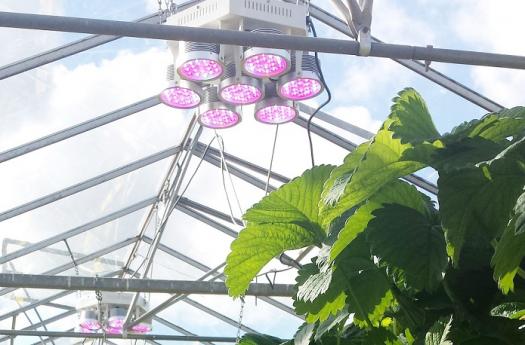Plessey readies for rapid LED market growth

With horticultural lighting pioneer, PhytoLux, in tow, Plessey is poised to seize its share of blossoming LED markets.
Horticultural LED lighting markets are growing; Plessey is ready.
Earlier this year, Plessey signed a global exclusive license agreement to manufacture and sell horticultural lighting products from UK-based PhytoLux.
As part of the deal, the UK-based LED manufacturer took on all operational, technical and commercial activities of the horticultural lighting firm, transferring staff from the PhytoLux headquarters in Leatherhead to its Plymouth LED facility.
With a hefty range of LED grow-lights in tow, Plessey will now integrate its GaN-on-silicon LEDs to these lighting units ready for delivery to horticultural markets across the world.
As Plessey chief executive, Michael LeGoff said at the time: "Our MAGIC technology is perfect for these direct lighting applications where we have tight wavelength control... Our next generation LEDs with electronics and optics will add to the intrinsic advantages of the PhytoLux products."
Plessey's move comes as the horticultural LED lighting market prepares for colossal growth. A recent research report from WinterGreen Research, US, put the market value of LED grow-light modules at $395 million in 2014, forecasting this figure to mushroom to $1.8 billion come 2021.
Growth is expected to primarily come from commercial greenhouse and factory growers switching from sodium lights to LEDs in a bid to reduce energy consumption and running costs or adopting lighting to expand the growing season.
But at the same time, agricultural research organisations and vertical farming pioneers worldwide are also set to adopt the technology. And given this market potential, Steve Edwards, ex-managing director of PhytoLux and now product director of PhytoLux lighting systems at Plessey is excited.
"We actually believe that these [WinterGreen] figures are a little conservative," he highlights.
"If you look at the white LED market today, you'll struggle to find a new build that doesn't specify LED lighting while most domestic homes have transferred to LEDs," he adds. "It's inevitable that the migration to LEDs in horticulture will come."
So given the market potential, what are Plessey's plans for its PhytoLux products right now? According to Edwards, the company has spent the last few months stripping down units and looking for ways to improve efficiency, achieving gains as high as 50%.
"The key benefits that Plessey's GaN-on-silicon LEDs bring are the thermal characteristics of the LEDs as well as the ability to incorporate chip-scale optics, that is, the beam-forming technology," says Edwards. "So as well as better efficiency we've also ended up with a much smaller heat-sink, which means we can make the entire unit smaller."
As Edwards points out, lighter and smaller units mean less weight and fewer shadows on the glasshouse roof. And as he adds: "Unit cost will come down and this cost-saving will be passed onto the end user."
The PhytoLux LED growth lights are configured to provide a broad spectrum of light at specific wavelengths within 460 to 660 nm, to optimise photosynthesis of a particular crop. As such, a lighting unit may contain more than 100 LEDs, which emit at red and blue wavelengths.
For blue LEDs, Plessey will use its own LEDs, manufactured at its Plymouth facility. But according to Edwards, red LEDs have been sourced from the likes of Osram and Cree, and this will continue, at least for now.
And while horticultural lighting units have been manufactured in the Far East, Plessey is now looking to transfer production to Europe, be it at Plymouth or elsewhere.
"We have a number of potential partners that we are looking to engage with on this," says Edwards. "However, we are also looking to bring some manufacturing of the unit into Plymouth itself, whether that's final assembly or sub-assembly work."
"Clearly the license agreement offers Plessey an opportunity to form some pretty good partnerships with new companies here," he adds.
Brave new markets
Looking to the future, Edwards believes commercial growers are ready to adopt the LEDs. "I've sensed a change in perception in the market place from questioning whether the LED can deliver to how do we make this work for our site," he claims. "We're going to see momentum build over the next five years and by then you will be hard-pressed to see sodium lights at a site."
At the same time, the product director is confident that Plessey will take a significant slice of this rapidly blossoming market. While Philips Lighting has led horticultural markets from as early as 2003, having already poured huge sums of money into this sector, PhytoLux, as a company, has dominated UK markets. And now as part of Plessey, PhytoLux products will be targeted at the rest of Europe and beyond.
"Philips will clearly dominate the market going forward but this is a huge market and the opportunities are vast," says Edwards. "There's plenty of scope for us in this market, and if we get a 5% share in the market [by 2021] we would be happy; 10% and we'd be delighted."


































